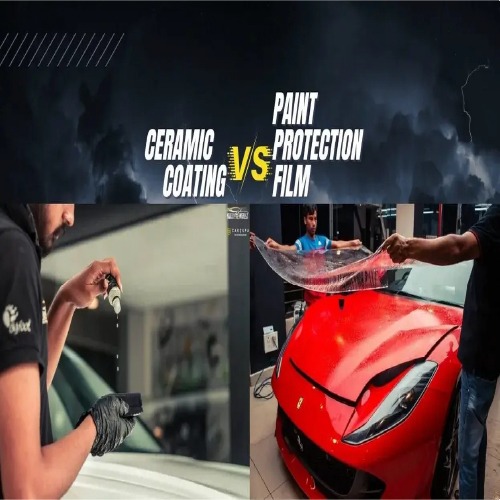
How to Maintain a Ceramic Coated Car
Ceramic coating has become a popular choice for car enthusiasts, offering superior protection and a stunning showroom shine. But unlike
a magic shield, a ceramic coating requires proper care to maintain its effectiveness. Here’s your ultimate guide to keeping your ceramic coated car looking flawless.
The First Wash is Crucial:
Wait for the cure: Freshly applied ceramic coatings need time to cure
(usually 24-48 hours). Resist the urge to wash your car and let the
coating fully bond with the paint.
Two-bucket wash: Employ the two-bucket wash method to minimize
the risk of scratching. One bucket holds clean soapy water for washing,
the other holds clean rinse water. Regularly rinse your wash mitt in the rinse bucket to prevent dirt transfer onto the paint.
pH-neutral soap: Skip harsh detergents and opt for a pH-neutral car
wash soap specifically designed for ceramic coatings. These soaps won’t strip away the coating’s protective layer.
Microfiber magic: Use high-quality microfiber towels for washing and
drying. Microfibers are gentle and absorb water effectively, minimizing
the risk of swirls and scratches.
Washing Like a Pro:
Weekly wash is ideal: Aim for a weekly wash to remove dirt, dust, and
bird droppings that can etch the paint if left unattended.
Rinse first: Before lathering with soap, thoroughly rinse the car to
remove loose dirt and debris. This prevents them from scratching the
surface while washing.
Wash in the shade: Avoid direct sunlight while washing, as hot water
and soap can cause streaking on the ceramic coating.
Two-step drying: After rinsing off the soap, use a clean microfiber
towel to gently pat dry the car. Follow up with a second dry microfiber
towel to buff the surface to a flawless finish.
Beyond the Wash:
Decontamination: Every few months, consider claying the car to
remove embedded contaminants like tar and iron deposits that regular
washing might miss. Use a clay bar specifically formulated for ceramic
coatings and follow CarsBuddy’s instructions.
Top-up sprays: Some ceramic coating manufacturers offer ceramic
spray products designed to boost hydrophobicity (water repellency) and add gloss. Apply these sprays as directed, typically after washing and drying.
Avoid harsh chemicals: Stay away from harsh chemicals like
degreasers or strong solvents, as they can degrade the ceramic coating.
Bird dropping defence: Act fast! Bird droppings are highly acidic and
can etch the paint if left for too long. Gently remove them with a damp
microfiber towel as soon as possible.
Bonus Tips:
Parking savvy: Whenever possible, park your car in a shaded area to minimize sun exposure and UV damage, which can break down the ceramic coating over time.
Winter blues: If you live in a cold climate with snow, ensure your car wash soap is formulated for cold water washing. Hot water can shock the
ceramic coating during winter washes.
Remember:
Consult the manual: Always refer to the specific care instructions
provided by the detailer of your ceramic coating.
Professional help: For deep cleaning or paint correction needs,
consider consulting a professional detailer like CarsBuddy experienced
with ceramic coatings.
By following these simple tips, you can ensure your ceramic coated car
continues to shine and maintains its superior level of protection for years to come. Now get out there and enjoy those head-turning glances while cruising in your ceramic-coated beauty!



